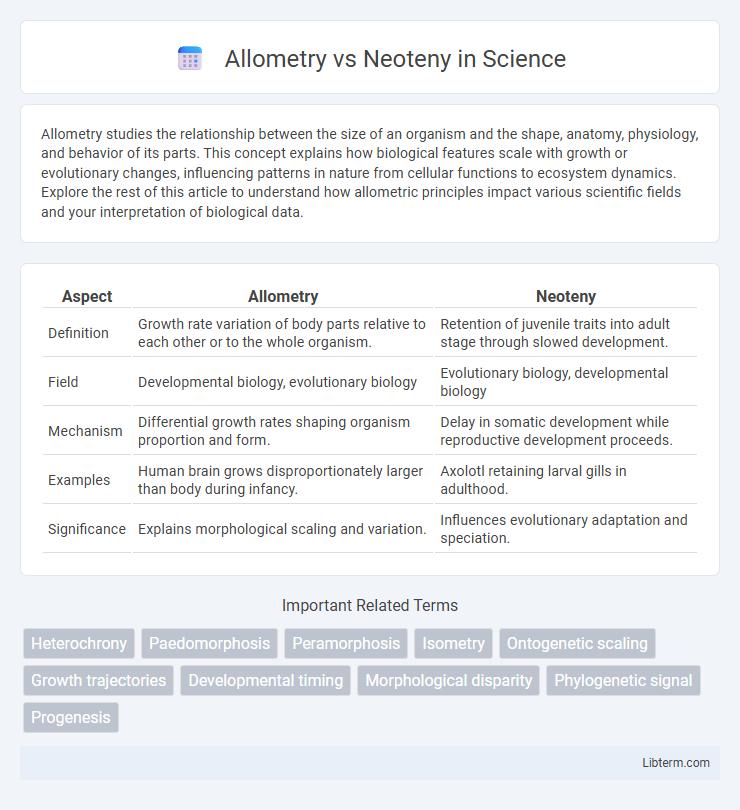Allometry studies the relationship between the size of an organism and the shape, anatomy, physiology, and behavior of its parts. This concept explains how biological features scale with growth or evolutionary changes, influencing patterns in nature from cellular functions to ecosystem dynamics. Explore the rest of this article to understand how allometric principles impact various scientific fields and your interpretation of biological data.
Table of Comparison
| Aspect | Allometry | Neoteny |
|---|---|---|
| Definition | Growth rate variation of body parts relative to each other or to the whole organism. | Retention of juvenile traits into adult stage through slowed development. |
| Field | Developmental biology, evolutionary biology | Evolutionary biology, developmental biology |
| Mechanism | Differential growth rates shaping organism proportion and form. | Delay in somatic development while reproductive development proceeds. |
| Examples | Human brain grows disproportionately larger than body during infancy. | Axolotl retaining larval gills in adulthood. |
| Significance | Explains morphological scaling and variation. | Influences evolutionary adaptation and speciation. |
Introduction to Allometry and Neoteny
Allometry examines the relationship between the size of an organism and the shape, anatomy, physiology, or behavior changes that occur as size varies, often expressed through scaling laws in biology. Neoteny refers to the retention of juvenile features in the adult stage of an organism, impacting evolutionary development by altering growth rates and timing. Both concepts are crucial in evolutionary biology, with allometry highlighting growth pattern changes and neoteny emphasizing developmental timing shifts.
Definitions: What is Allometry?
Allometry is the study of the relationship between the size of an organism and the shape, anatomy, physiology, or behavior of its parts, highlighting how different body parts grow at different rates. This biological principle explains variations in growth patterns that contribute to the morphological diversity among species. Allometric scaling is critical in understanding evolutionary adaptations and developmental processes across taxa.
Defining Neoteny in Biology
Neoteny in biology refers to the retention of juvenile features in the adult stage of an organism, resulting from a slowed or delayed development process. This phenomenon contrasts with allometry, which studies the differential growth rates of body parts relative to the whole organism. Neoteny plays a significant role in evolutionary biology by contributing to morphological diversity and influencing species adaptation.
Key Differences Between Allometry and Neoteny
Allometry refers to the differential growth rates of body parts relative to the whole organism, influencing shape and size during development, whereas neoteny involves the retention of juvenile traits into adulthood due to slowed or delayed somatic development. Allometry is a broader concept encompassing various scaled growth patterns, while neoteny specifically relates to developmental timing shifts that result in adult individuals maintaining juvenile characteristics. Key differences highlight allometry's focus on proportional growth changes and neoteny's emphasis on developmental timing and maturation processes.
Allometry: Mechanisms and Examples
Allometry examines the relationship between the size of an organism and the proportional growth of its parts, revealing how differential growth rates influence shape and function during development. Mechanisms of allometry involve genetic regulation, hormonal control, and environmental factors that modulate growth patterns, resulting in varied morphological traits such as enlarged limbs in some insects or disproportionate skulls in mammals. Classic examples include the enlarged claws of fiddler crabs and the extended beaks of certain bird species, highlighting how allometric changes drive adaptive evolution.
Neoteny: Mechanisms and Examples
Neoteny, a form of heterochrony, involves the retention of juvenile characteristics into adulthood through slowed or delayed somatic development, often resulting from hormonal regulation changes such as altered growth hormone or thyroid hormone levels. This mechanism is exemplified in species like the axolotl, which maintains larval gills and aquatic traits throughout life, and in domestic dogs, where juvenile skull shapes persist compared to wolves. Neoteny impacts evolutionary processes by enabling phenotypic plasticity and morphological innovation, contributing to species diversity and adaptation.
Evolutionary Significance of Allometry
Allometry examines how the growth rates of different body parts evolve at varying scales, influencing morphological adaptations and phenotypic diversity in species. This differential growth plays a crucial role in evolutionary processes by enabling organisms to develop specialized structures that enhance survival and reproductive success. By shaping the proportional relationships among traits, allometry drives evolutionary innovation and contributes to the adaptive radiation observed across taxa.
Evolutionary Impact of Neoteny
Neoteny, the retention of juvenile traits into adulthood, significantly influences evolutionary trajectories by promoting developmental plasticity and facilitating rapid adaptation to environmental changes. This evolutionary mechanism contrasts with allometry, which involves differential growth rates leading to changes in shape and size but may not directly affect developmental timing. Neoteny's impact is evident in species like humans, where extended juvenile features contribute to cognitive development and complex social behaviors, thereby driving evolutionary innovation.
Role in Development and Growth Patterns
Allometry describes how the relative growth rates of different body parts lead to changes in shape or size during an organism's development, reflecting differential gene expression and hormonal regulation. Neoteny involves the retention of juvenile traits into adulthood by slowing developmental processes, often resulting in unique growth patterns and morphological features. Both mechanisms influence developmental timing and growth trajectories, shaping evolutionary adaptations in various species.
Allometry vs Neoteny: Comparative Analysis and Conclusion
Allometry examines the differential growth rates of body parts relative to the whole organism, revealing how shape and size evolve through ontogeny, while neoteny emphasizes the retention of juvenile features in adult stages due to slowed developmental processes. Comparative analysis shows that allometry drives morphological diversity through proportional scaling, whereas neoteny contributes to evolutionary novelty by pausing or altering developmental timing. Understanding these concepts clarifies mechanisms behind evolutionary adaptations and morphological variation in species.
Allometry Infographic

 libterm.com
libterm.com